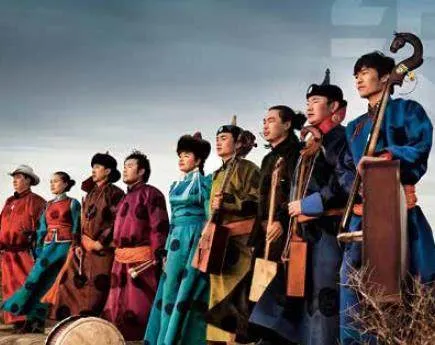美丽的草原音乐
2024-01-01傅美玲


在辽阔的大地上,与自然融为一体的蒙古族人以天为幕布,以地为舞台,用歌声演绎生活的一切。以歌为媒,表达内心的情愫,唱着对家乡的思念,唱尽与自然的对话。
On the vast grasslands, the Mongolian people, in harmony withnature, use the sky as their backdrop and the earth as their stage. Theyexpress every aspect of life through their songs. Through this musicalmedium, they convey their innermost emotions, sing of their longingfor home, and engage in a profound dialogue with nature.
蒙古族的歌
The Songs of the MongolianPeople
在很多人看来,蒙古族是马背上的民族,他们的音乐大多英姿飒爽、雄浑壮阔,其实并不尽然。听过了蒙古族长调,人们仿佛能触及蒙古族人那缎子一样柔软的心肠,感受到无尽的柔情。
To many, the Mongolians are knownas a people on horseback, and their musicis often perceived as bold and majestic.However, this is only part of the story. Uponhearing the Mongolian long songs, one canalmost sense the silk-like softness of theMongolian people’s hearts and feel theirboundless tenderness.
长调的特Xd5A79GCxrKxcdQVo+KSSSAJXxsPkCG1PLGEcT/fVeI=点和魅力在于轻柔、绵长而不“完”。当长调的乐声响起,世界仿佛只有它的声音。仿佛是母亲哄婴儿入睡时的低语,是大海在静谧的夜晚轻拍礁石的浪花声,是无垠的草原上牛儿对着远方发出的哞哞声,绵延不绝。
The unique charm of long songs liesin their gentle, extended, and “unending”nature. When the melody of a long songbegins, it seems to be the only sound in theworld. It resembles a mother’s soft whisperlulling her baby to sleep, the gentle lappingof waves against rocks on a quiet night,or the endless lowing of cattle across theboundless grasslands.
同样不“完”的,还有长调艺术的传承和发展。提起长调,就必须说到蒙古族音乐史上的一位史诗级人物——蒙古族“歌王”哈扎布。他的传奇人生为长调艺术增添了更加迷人的色彩。少年时的哈扎布天赋异禀,他的歌声受到极高的认可。然而生逢乱世,哈扎布被乱兵追杀。穷极之时,他准备用长调的歌声与世界道别,然而正是这歌声拯救了自己,也保住了长调的未来。之后,哈扎布将长调带出草原,搬上舞台,唱响世界。晚年时,哈扎布教书育人,为长调培养传承者。“哈扎布”意为“天的恩赐”,哈扎布和他的长调歌声正是上天留给世界的礼物。
Similarly, the inheritance and developmentof the art of long songs is “endless.” Whendiscussing long songs, one cannot overlook aniconic figure in Mongolian music history — the“King of Songs,” Hajab. His legendary life addedeven more allure to the art of long songs. As ayoung man, Hajab displayed exceptional talent,and his singing was widely praised. However, hewas born in a time of turmoil and found himselfpursued by rebel soldiers. At his lowest point,Hajab prepared to bid farewell to the world withthe sound of a long song. Yet, it was this verysong that saved him, securing the future of longsongs. In the years that followed, Hajab broughtthe art of long songs from the grasslands to thestage, making them resonate throughout theworld. In his later years, he dedicated himselfto teaching and nurturing the next generationof long song singers. The name “Hajab” means“gift from heaven,” and both Hajab and his longsongs remain a heavenly gift left to the world.
蒙古族的乐器
Mongolian Musical Instruments
在蒙古族人眼中,马头琴是“草原音乐之魂”,在内蒙古音乐中扮演着不可替代的角色。关于马头琴的来历,民间流传着一个动人的故事:有一个叫苏和的牧羊少年拥有一匹心爱的白马。一次赛马会上,白马夺得了第一名。然而,贪心的王爷眼红,抢走了白马。白马思念主人,脱缰而逃,却不幸被王爷的毒箭射杀。伤心的小苏和为纪念死去的小马,以其骨为柱,尾毛为弦,按小马的模样雕刻马头装于琴顶,让小马与自己朝夕相伴,永不分离。
To the Mongolian people, the morinkhuur (horse-head fiddle) is the “soul ofgrassland music,” playing an irreplaceablerole in Inner Mongolian music. There is a touching folk tale about its origin: A young shepherdnamed Suho had a beloved white horse. During ahorse race, the white horse won first place, but agreedy prince, envious of its victory, stole it. Longingfor its owner, the white horse managed to escape butwas tragically killed by the prince’s poisoned arrow.Heartbroken, Suho decided to honor his horse bycrafting an instrument from its remains. He used itsbones as the pillar, its tail hair for the strings, andcarved a horse’s head at the top in memory of hisloyal companion. In this way, the horse would remainwith him always, never to be parted.
从此,骏马不仅被刻在琴首上,也被唱进歌里。马头琴是长调最好的配器,每当悠扬的长调响起,都会伴有马头琴声的优美回荡。最初草原上各地的马头琴长得都不一样,琴的大小、弦的数量,都没有统一,音量也比较轻。现代马头琴的改良与兴起与一个人息息相关,他就是马头琴宗师齐 · 宝力高。他从小就迷恋马头琴,学会了演奏。16岁时,他拥有了人生中第一把属于自己的马头琴,同年他被选入中央音乐学院。在校学习期间,他深切感受到马头琴与现代乐器相比较落伍,他也无法用它与其他乐器进行合奏,甚至还因此受到了鄙视和嘲笑。
Since then, the image of the steed has not onlybeen carved into the head of the fiddle but has alsobeen immortalized in song. The morin khuur is theideal accompaniment for long songs. Whenever themelodious notes of a long song are heard, they arealways harmonized with the beautiful echoes of themorin khuur. In the beginning, morin khuurs variedin design across different regions of the grasslands,with no uniformity in size, string number, or volume,resulting in relatively soft sound. The modernizationand enhancement of the morin khuur are closelytied to one individual: Chi Bulag, a master of theinstrument. From a young age, he was captivated by themorin khuur and learned to play it. At 16, he acquiredhis first personal morin khuur, and in the same year,he was admitted to the Central Conservatory of Music.During his studies, he realized that the morin khuurwas outdated compared to modern instruments andtried unsuccessfully to integrate it into performanceswith other instruments, even facing contempt andridicule because of its limitations.
意气风发的少年下定决心要对马头琴进行改良。这一改,就是60年。经过潜心钻研,齐 · 宝力高最终改变了琴的形制,扩大了音量,增强了音域,加强了琴弦强度,优化了琴声,改善了琴面,甚至统一了马头琴的弓法和指法。正是有了这些改革,马头琴这一乐器得以规范化,从而能够与世界音乐接轨,并且为更多的年轻人喜爱,活得越来越“年轻”。
The spirited young Chi Bulag was determined toimprove the morin khuur, a process that would span60 years. Through dedicated research, he successfullytransformed the instrument by altering its structure,increasing its volume, extending its range, reinforcingthe strings, optimizing its sound quality, and refiningthe soundboard. He also standardized the bowing andfingering techniques for the morin khuur. Thanks tothese reforms, the instrument became standardized,making it compatible with the music of the world. Asa result, the morin khuur gained popularity amongyounger generations, becoming more modern and“youthful.”
蒙古族的音乐人
Mongolian Musicians
如果说齐 · 宝力高播下了蒙古族音乐的种子,那么在今天,内蒙古的音乐传承人正努力让他们的音乐在地球上遍地开花。歌手、乐队、独立音乐人等不同的音乐创作群体纷至沓来,为蒙古族音乐添加了流行、摇滚、说唱等多样的元素。这些音乐的火花相互碰撞,产生了一种微妙的融合,使蒙古族音乐更具有独特魅力。
If Chi Bulag sowed the seeds of Mongolianmusic, then today, the inheritors of Inner Mongolianmusic are striving to let their music bloom all overthe world. Various creative groups, including singers,bands, and independent musicians have emerged toadd diverse elements such as pop, rock, and rap toMongolian music. When these musical sparks collide,they create an exquisite fusion, making Mongolianmusic uniquely charming.
“草原歌王”腾格尔是如今在内蒙古乃至全中国范围内歌曲传唱度都很高的一位蒙古族歌手。“蓝蓝的天空,清清的湖水……”,当这一旋律响起,没有人会抗拒得了和他一起闭上眼睛,从内心感受草原。他在音乐创作与演唱中,善于从民族、民间音乐中汲取营养,不断推出具有浓郁蒙古族风格的通俗歌曲。从流行到摇滚,甚至是电子音乐,他在音乐之路上的探险永不停歇。
Tengger, “the King of Grassland Songs,” is ahighly popular Mongolian singer in Inner Mongoliaand throughout China. “The blue sky, the clearlake…,” whenever this melody sounds, no one canresist closing their eyes and feeling the grasslandin their heart with the singer. In his creation andperformance, Tengger skillfully draws nourishmentfrom ethnic and folk music, producing pop songswith a pronounced Mongolian style. From popto rock, and even electronic music, his musicalexploration never stops.
内蒙古乐队也如雨后春笋般纷纷崭露头角。2004年,一支名叫杭盖的摇滚乐队在北京诞生。他们将蒙古乐与流行乐、摇滚乐、古典乐等其他乐种相结合,带有浓浓的蒙古味。在国际上,他们是最负盛名的蒙古族乐队,足迹遍布60余个国家,演出超500场,让世界听见了内蒙古的声音。
Inner Mongolian bands havealso sprung up like mushrooms afterthe rain. In 2004, a rock band namedHanggai was formed in Beijing. Theycombine Mongolian music with pop,rock, classical, and other genres,creating a uniquely Mongolianflavoredmusic. Internationally, theyare the most renowned Mongolianband, having performed over 500shows in more than 60 countries,bringing the sound of Inner Mongolia to the world.
此外,九宝乐队将蒙古族传统音乐的调性与金属乐结合得顺理成章,将节奏、血性与优美而悠扬的旋律完美融合;HAYA乐团的声音充满东方的神韵与自然的灵性,唱出了蒙古族人深沉而内敛的性格;安达组合是“背着传统乐器的当代乐队”,他们背着民族乐器,唱着民族语言,讲述着民族史诗,在这个变换无穷的世界中坚守着民族的特质。他们和更多想将蒙古族音乐带到更广阔世界的年轻人一起,抒发着情怀。这些美丽的音乐既是民族的,也是世界的。正是这个缘由,草原音乐才走出国界,广为人知和喜爱,走得越来越远。
Apart from this, there is the band Nine Treasures,which seamlessly blends the tones of traditionalMongolian music with metal, perfectly integratingbeats and vigor with beautiful, melodious tunes;the band HAYA, whose music is filled with Easterncharms and the spirit of nature, singing out the deepand reserved character of the Mongolian people; theband Anda Union, a “modern band with traditionalinstruments,” singing in ethnic languages and tellingethnic epics, preserving ethnic characteristics in thisever-changing world. Together with many youngpeople who want to bring Mongolian music to abroader world, they express themselves in theirsongs. Their beautiful music is both ethnic andglobal. It is because of this that grassland music hascrossed borders and gained worldwide renown andadmiration, continuing to travel further.
